- Updated: December 14, 2022
Do Golf Balls Go Bad?
Yes, golf balls can absolutely “go bad,” but usually, some damage (Chips, Scratches, Cuts, Scuffs) from an external source has to happen to the golf ball first to enable the golf balls to lose their quality.
Determining when a golf ball has gone bad is one of the most essential equipment factors that goes overlooked in this game!
Besides the noticeable wear and tear a golf ball receives from rattling around trees or glancing off cart paths, the materials used to construct its cover, how you store your golf balls between use, and what manufacturers you’re purchasing your golf balls from are the additional main factors that influence a golf ball going bad.

Does A Golf Ball go bad in water?
Many people say a golf ball cannot be “water logged.” Still, from personal experience, prolonged exposure to water can absolutely “water log” a golf ball IF it had a deep enough scratch, scuff, or cut to allow water inside its cover.
If a golf ball has no damage to its surface or exterior and is then placed in water, it will likely see no “water logging” aspects for at least a few months.
To put this theory to the test, the team over at “Golf Ball Divers” commissioned a University-ran, independent research study to compare the statistics of new golf balls to balls that were submerged in a golf courses pond for 1, 3, and 5 months.
Using Trackman to see the golf balls’ performance statistics, the University study found “no discernible loss in distance or performance.” in the balls that were underwater for the specified lengths of time.
If you’re not sure how long the ball has been underwater, look to see a significant amount of sharp discoloration, swelling, or a deformed appearance, or pick the ball up and see if it feels heavier than usual.
If any of the three factors listed above are true, the ball likely had damage significant enough to its surface for water to seep in, causing its “water logged” state.
How to tell if a golf ball has gone bad
Let’s face it. Playing a brand new ball for every round can be too costly for many golfers out there.
At the same time, we want to ensure we aren’t making golf harder on ourselves by using a “bad ball” that doesn’t perform to the standards we need.
Below we’ll show you how we determine if a golf ball is worth;
1. Keeping it in your bag and in play.
2. Moving the slightly damaged balls to the ever-important “Shag Bag” (Bag that holds balls used for practice)
3. Discarding or donating the balls entirely.
Additionally, we included some tips and information about how to ensure you’re not being taken advantage of when purchasing balls and how to make sure your golf balls last for as long as possible! (Details the Golf Ball Researchers/Manufacturers don’t want you to know about!)
We begin with the factor that influences golf balls “going bad” the most, their covers.
A Golf Ball's Life-Span Is 1st Determined By Its Cover
The material used to construct the golf balls cover by golf ball manufacturers determines if a golf ball will last for a long period of time.
Standard modern golf balls covers are constructed using one of three materials:
“Urethane”
“Ionomer”
“Surlyn”
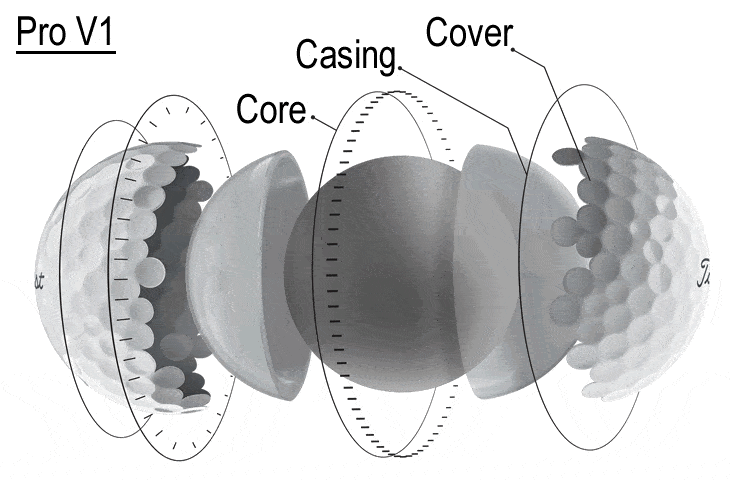
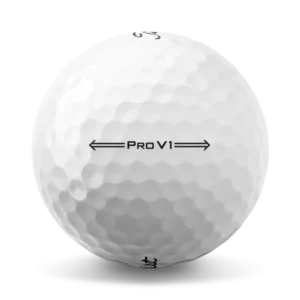
Urethane is widely regarded as the softer cover material used in “Tour,” “Advanced,” and “Performance” golf balls. It’s softer and less durable than Ionomer and Surlyn, resulting in faster damage to the golf balls. Still, the added spin and feel will be enough of an advantage that many high level players refuse to use any other cover material.
Our Recommendation: Have a low handicap if you want to consistently play the most expensive and most likely to be damaged Urethane cover golf balls.
Surlyn covered golf balls are generally cheaper than Urethane coated balls, are stronger and more durable by comparison, and are usually focused on maximizing distance and creating less spin.
Our Recommendation: If you’re a beginner player or high handicapper, use cheaper Surlyn golf balls. They’ll last longer and provide more distance than their Urethane counterparts.
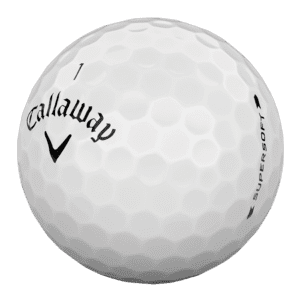
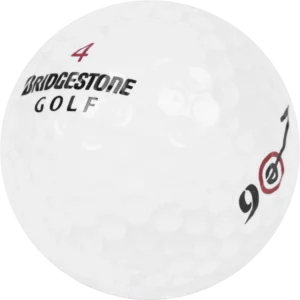
Ionomer is another polymer used to cover golf balls, but it finds itself as a sort of “middle ground” between the softest feeling, Urethane, and the hardest feeling Surlyn. Interestingly, Ionomer can be engineered to be softer (like some Srixons) but will be damaged just as fast as the Urethane covers if so. Most Ionomer cover golf balls are made to be firm like Surlyn, just with some added benefits regarding spin and feel potentially added.
Our Recommendation: DO RESEARCH before you purchase an Ionomer cover ball and see what the manufacturers are promising. If added spin, feel, or touch around the greens is promised, you’re likely looking at a soft cover Ionomer and will see damage happen faster from regular use.
The "Dime Test" & Checking Golf Balls for Wear
We looked towards the experts at Titleist (the No. 1 Ball in Golf) to figure out how to determine if a golf ball should stay or be removed from our bags.
According to a Titleist representative, Titleist has considerable communication with “regular golfers” and even has players who write the company about the durability and performance of their balls. They’ve amazingly had players send photo evidence of the same ball being used for over 120 consecutive holes.
Titleist claims that their rule of thumb for regular golfers is, “as long as paint loss, a scuff or defacement on the golf ball is less than the size of a dime, it should be good to go.”
A practice I live by is checking my golf balls for cuts, scuffs, or any potentially distracting marks while warming up before a round.
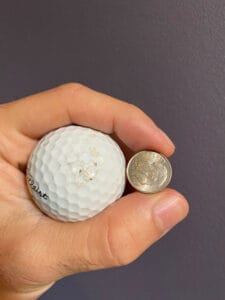
As I referenced in the photo above with my own ball, this golf ball has a cart path scuff just slightly larger than a dime and will no longer be in regular play for myself.
That DOESN’T MEAN that the golf ball is instantly going to the dumpster…
Below we list some alternatives to do with golf balls that have “gone bad.”
The Last Resort: How to Properly Repurpose or Donate Old Golf Balls?
1. Make a “Shag Bag.”
Having a small bag (carries maybe 30 balls) that you can take with you to your local golf course for the chipping green or short game areas makes practice so much easier.
Not only do you always have a stash of balls to practice your short game with, but you also no longer have to rely on golf courses to provide practice balls for you.
2. Give them away to friends or your local driving range.
Above is a photo of a large bucket of golf balls I’ve either damaged and retired or found while playing and don’t want to keep.
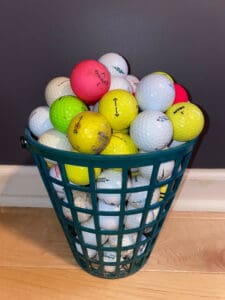
If you have golfing pals you play with frequently, ask them if they need any balls. You can save your friend(‘s) some money and do something nice!
Additionally, if you don’t have anywhere to turn as far as giving the balls away, your closest driving range will likely LOVE the donation and could even reimburse you with some free range practice.
3. Donate to Programs like “Bunkers in Baghdad” and the “First Tee.”
Bunkers in Baghdad is a not-for-profit charity that has collected and sent new and used balls, clubs, and other equipment to troops located around the world for the last 13 years.
The First Tee Program is a youth development program that helps kids build strength of character through the game of golf. If you live near an area with a First Tee Program, they gladly accept and resell your used balls for added funding for the children.
"Recycled" and "Used" Golf Balls Can Be GREAT!
Websites like “Lost Golf Balls” and “Found Golf Balls” sell “recycled” and “used” balls at a significant discount.
“Recycled” and “Used” golf balls are essentially glorified ways of saying “washed and cleaned once found.” They don’t receive any new covers, new paint, or new finishes after they’ve been cleaned.
The quality of “Recycled” and “Used” golf balls will be drastically greater than their “Refinished” and “Refurbished” counterparts.
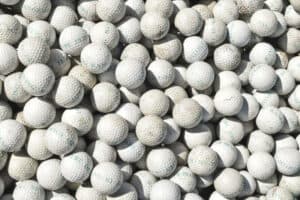
"Refinished" and "Refurbished" Golf Balls Can Be TERRIBLE!
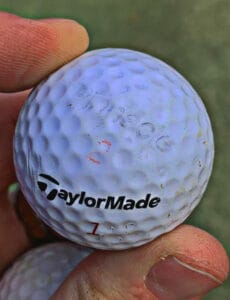
“Refinished” golf balls are wet blasted to remove their original logo, number, and any other marking on the golf ball. The ball then gets a new clear coat, is repainted, and clear coated again. The ball is then usually stamped with a “Refinished” marking to alert players.
As you can see from the photo above, this golf ball was previously a “Pinnacle 3,” but following the “refinishing” process, it was turned into a “TaylorMade” ball…
“Refurbished” golf balls are the same thing as a “refinished” golf ball. The verbiage used is just a marketing ploy to get more customers!
FINAL THOUGHT ON "USED" vs. "REFINISHED/REFURBISHED"
The cost difference between “Used” balls and “Refinished” balls does not justify the fact that you may not be hitting what you’re actually purchasing! If you’re going with the 2nd hand golf ball market, stick to “Used” and “Recycled” and avoid “Refurbished” or “Refinished.”
Proper Storage Will Extend Every Golf Balls Life!
Having played golf for the better part of the last 2 decades, I’ve heard endless myths about how to store your golf balls to increase your performance on the course.
These myths include tales of storing golf balls in the freezer to preserve the longevity of the core of the ball and storing them in heated boxes to increase their compression for more distance.
Both ideas are untrue, harmful to modern golf balls, and actually cause the opposite results with both tactics!
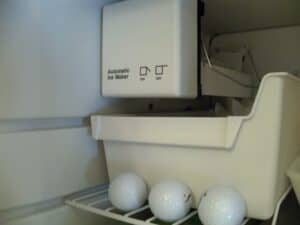
Frozen golf balls decrease ball speed, increase spin rates, and decrease distance drastically.
Warmed golf balls lower the compression rating substantially, harming distance for players with a swing speed over 85 mph.
Prolonged exposure to excessive heat or essentially either end of the temperature scale can cause golf balls to “go bad” much faster than in normal indoor conditions.
The ball’s core can expand or contract, altering the results you expect from your new golf balls.
Final Thoughts on Proper Golf Ball Storage
Golf ball makers determined the shelf life of the modern golf ball through extensive testing, and none of that testing includes storing your golf balls in the freezer or under your fireplace.
Don’t even store your golf balls in your vehicle or garage! Prolonged exposure to extreme temperatures and other factors (water, etc.) can decrease your distances and affect your golfing experience without you even knowing!
Store your golf balls in a dry place, preferably between 70 and 80 degrees Fahrenheit, and they will last for as long as you want them to.
Thank You, Tiger & Phil, For Changing Golf Balls Forever
Many golfers might not know this, but until Tiger Woods in 2000, basically every high level golfer used “Balata” golf balls for their soft feel and high spin rates around the greens. For those who don’t know, Balata balls got their name from the “Balata Tree” located in South America, which produces the rubber-like liquid that was used for the cover for the Balata golf balls covers.
The ultimate issue with the Balata golf ball era was that they were relatively expensive for regular players at the time, and their resistance to damage was so poor that even a thinly struck iron shot would cut the cover, rendering the golf ball useless.
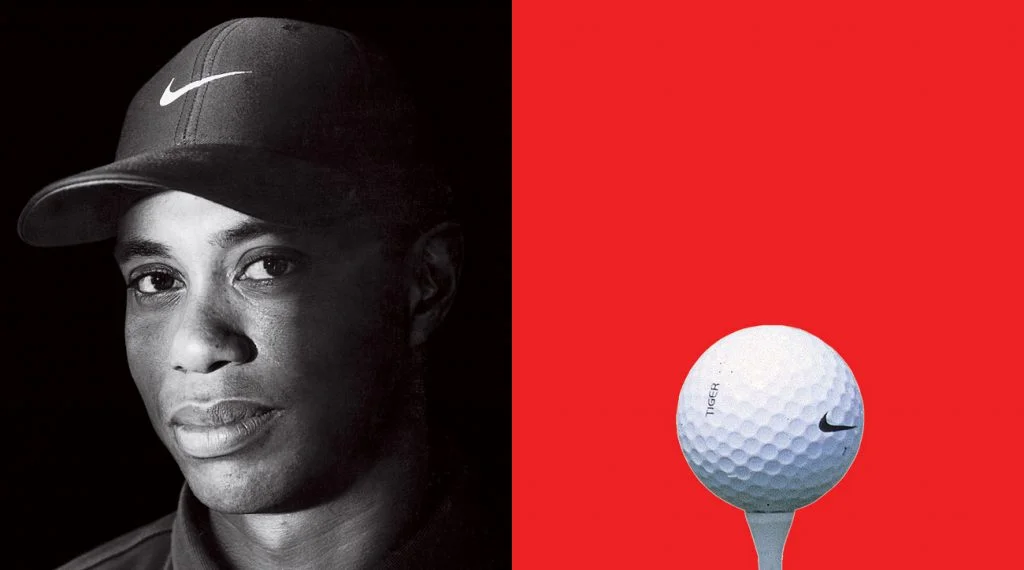
Tiger forever changed the professional golf ball landscape by implementing a new solid core ball called the “Nike Tour Accuracy” in the 2000 PGA Tour season.
He used it to become the first player since Ben Hogan to win 3 Majors in a single year, along with completing the “Tiger Slam” (being the winner of every Major tournament at once) the following year with the new golf ball.
Tiger found the new Urethane covered, solid centered golf balls delivered the same distance as a hard-feeling two-piece ball, had the soft feeling and short game performance of the previously adored Balata’s we mentioned earlier, but additionally had a much longer lifespan.
That same year, during his final round press conference after winning the Tour Championship, Phil Mickelson stated, “I honestly believe that if you are not playing this golf ball [the Pro V1], then you are at a distinct disadvantage to the entire field.”
The golf ball business would never be the same.
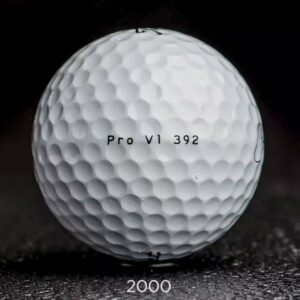
About The Author
Writers of Independent Golf Reviews
Independent Golf Reviews has tested and reviewed 1000+ golf products over the past 10 years. We use our experience and expertise to give golfers an unbiased insight on the market.
Read more…
Share
Receive the best golf discounts available exclusively for our subscribers and be auto entered into our monthly golf giveaways!
Success!⛳️
You are now an official member of IGR. Keep an eye out for the perks.
No spam, ever. 🔒

